1995 CADILLAC ELDORADO belt
[x] Cancel search: beltPage 70 of 395
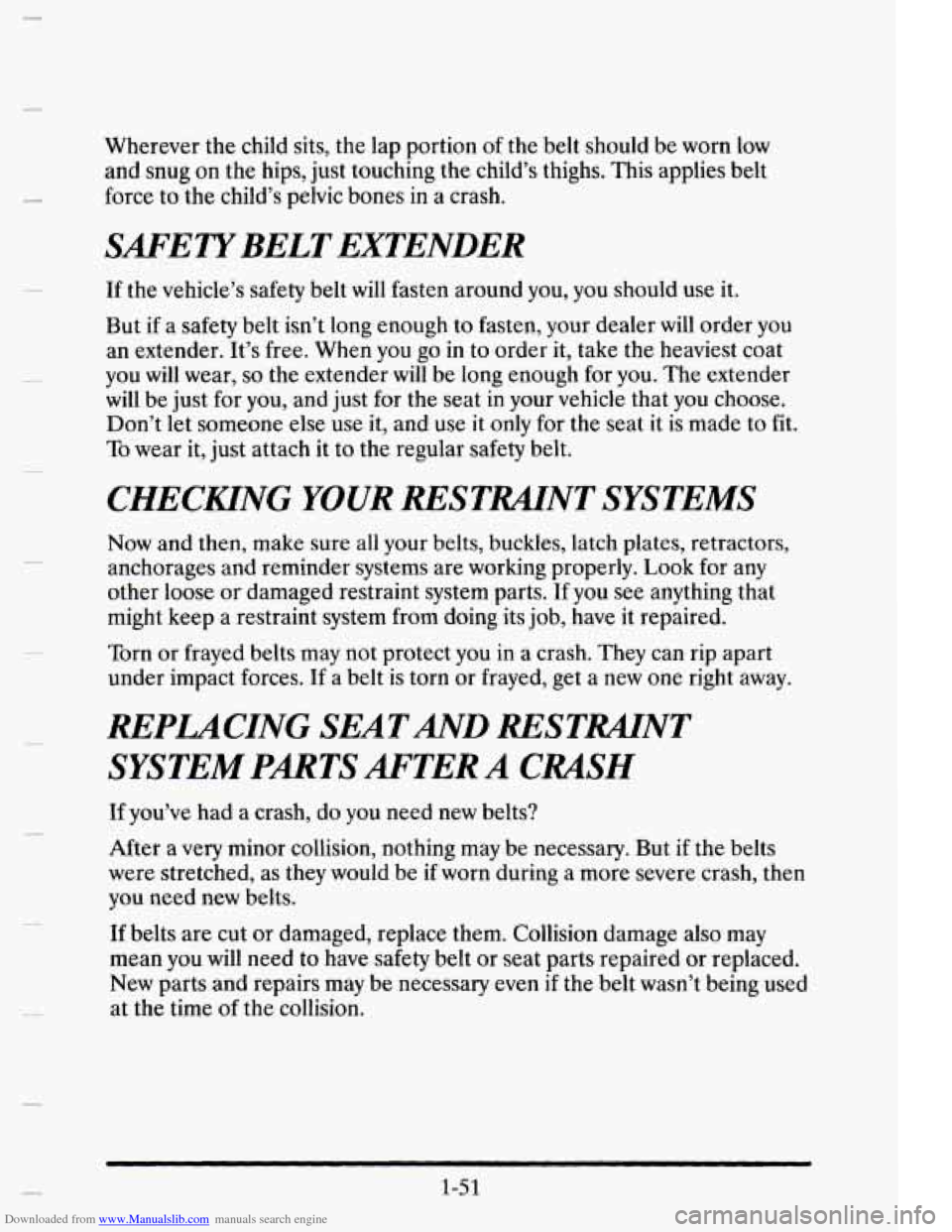
Downloaded from www.Manualslib.com manuals search engine I
Wherever the child sits, the lap portion of the belt should be worn low
and snug on the hips, just touching the child’s thighs. This applies belt
force to the child’s pelvic bones in a crash.
SAFEWBELT EXTENDER
If the vehicle’s safety belt will fasten around you, you should use it.
But if a safety belt isn’t long enough to fasten, your dealer will order you
an extender. It’s free. When you go in
to order it, take the heaviest coat
you will wear, so the extender will be long enough for you. The extender
will be just
for you, and just for the seat in your vehicle that you choose.
Don’t let someone else use it, and use it only for the seat it is made to fit.
To wear it, just attach it to the regular safety belt.
CHECKING YOUR RESTMNT SYSTEMS
Now and then, make sure all your belts, buckles, latch plates, retractors,
anchorages and reminder systems are working properly.
Look for any
other loose or damaged restraint system parts. If you see anything that
might keep a restraint system from doing its job, have it repaired.
Torn or frayed belts may not protect you in a crash.
They can rip apart
under impact forces. If a belt is torn
or frayed, get a new one right away.
REPLACING SEATAND RESTWNT
SYSTEM PARTS AFTER A CRASH
If you’ve had a crash, do you need new belts?
After a very minor collision, nothing may be necessary. But
if the belts
were stretched, as they would be if worn during a more severe crash, then
you need new belts.
If belts are cut or damaged, replace them. Collision damage also may
mean you will need to have safety belt
or seat parts repaired or replaced.
New parts and repairs may be necessary even
if the belt wasn’t being used
at the time
of the collision.
1-51
Page 144 of 395

Downloaded from www.Manualslib.com manuals search engine When one of the warning lights comes on and stays on when you are
driving, check the section that tells you what to do about it. Please follow
this manual’s advice. Waiting to
do repairs can be costly -- and even
dangerous.
So please get to know your warning lights. They’re a big help.
Your vehicle may also have a Driver Information Center that works along
with the warning lights. See “Driver Information Center’’ in the Index.
Safety Belt Reminder Light
c
When the key is turned to RUN or START, a chime will come on for about
eight seconds to remind people to fasten their safety belts. The safety belt
light
will also come on and stay on for about 75 seconds. If the driver’s belt
is already buckled, neither the chime nor the light
will come on.
2-73
Page 185 of 395
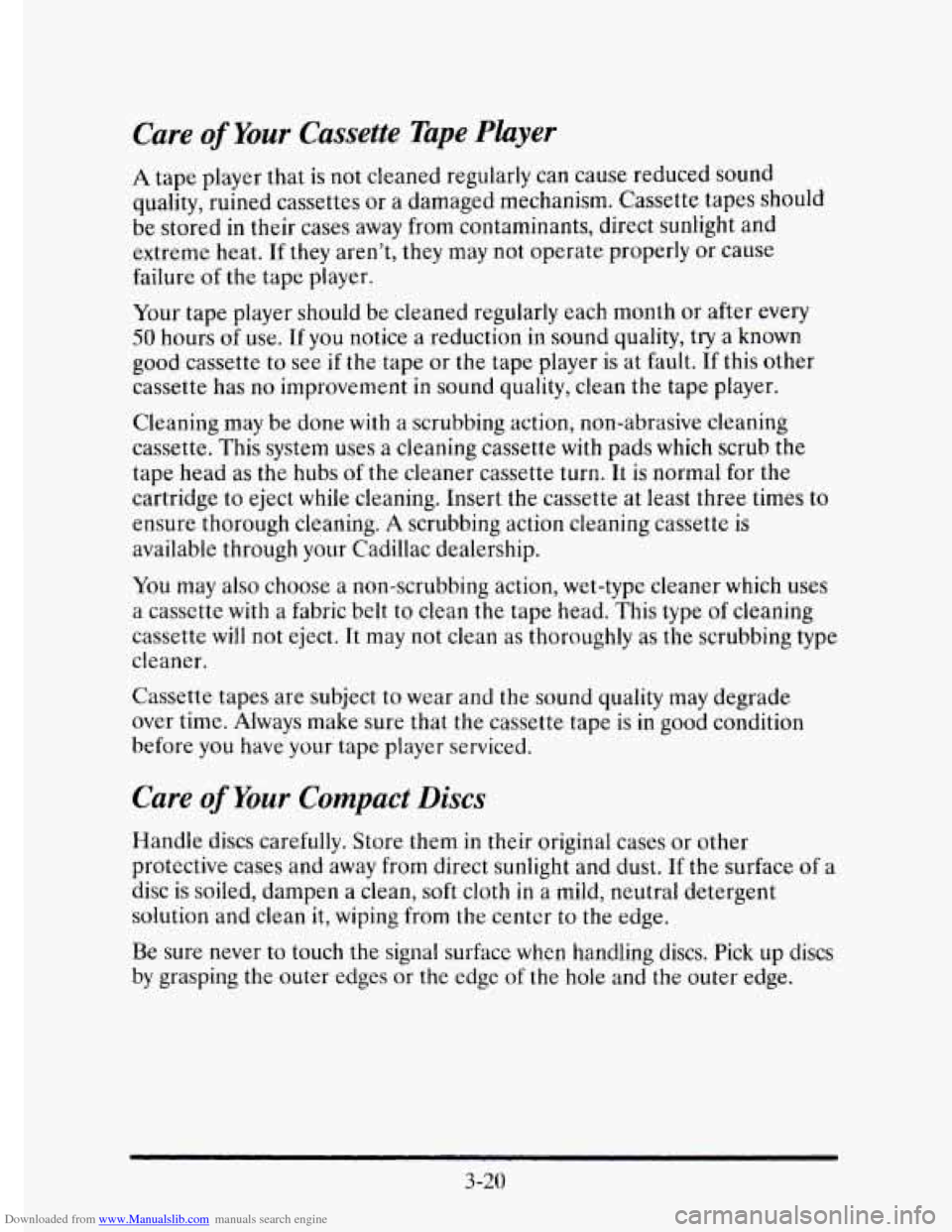
Downloaded from www.Manualslib.com manuals search engine Care of Your Cassette Tupe Player
A tape player that is not cleaned regularly can cause reduced sound
quality, ruined cassettes or a damaged mechanism. Cassette tapes should
be stored
in their cases away from contaminants, direct sunlight and
extreme heat. If they aren’t, they may not operate properly or cause
failure
of the. tape player.
Your tape player should be cleaned regularly each month or after every
SO hours of use. If you notice a reduction in sound quality, try a known
good cassette to see
if the tape or the tape player is at fault. If this other
cassette
has no improvement in sound quality, clean the tape player.
Cleaning may be done
with a scrubbing action, non-abrasive cleaning
cassette. This system uses a cleaning cassette
with pads which scrub the
tape head as the hubs
of the cleaner cassette turn. It is normal for the
cartridge to eject while cleaning. Insert the cassette at least three times
to
ensure thorough cleaning. A scrubbing action cleaning cassette is
available through your Cadillac dealership.
You may also choose
a non-scrubbing action, wet-type cleaner which uses
a cassette
with a fabric belt to clean the tape head. This type of cleaning
cassette
will not eject. It may not clean as thoroughly as the scrubbing type
cleaner.
Cassette tapes are subject to wear
and the sound quality may degrade
over time. Always make sure that the cassette tape
is in good condition
before you have your tape player serviced.
Care of Your Compact Discs
Handle discs carefully. Store them in their original cases or other
protective cases and away from direct sunlight and dust. If the surface
of a
disc is soiled, dampen a clean, soft cloth
in a mild, neutral detergent
solution and clean
it, wiping from the centcr to the edge.
Be sure never to touch the signal surface when handling discs. Pick up discs
by grasping the outer edges or the edge of the hole and the outer edge.
3-20
Page 188 of 395
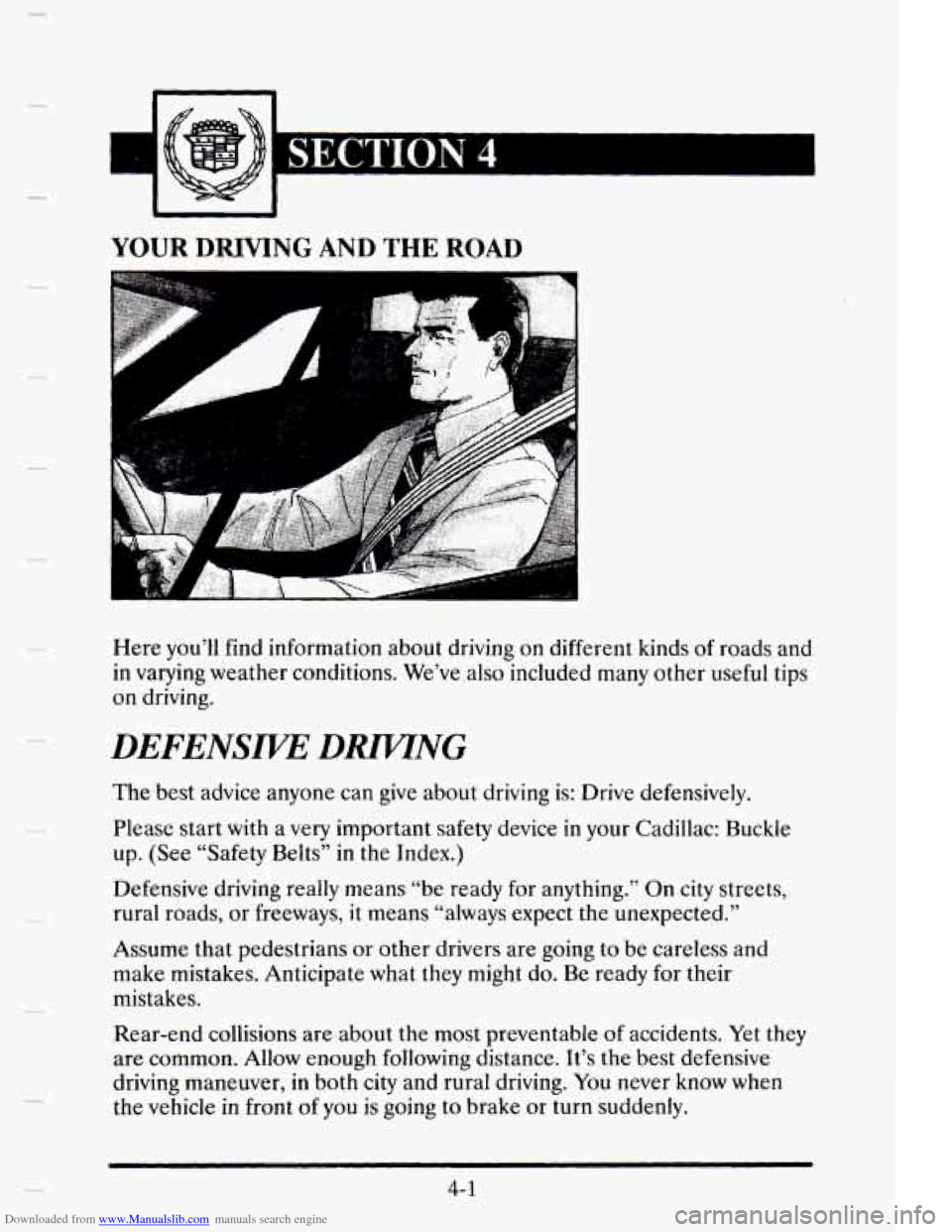
Downloaded from www.Manualslib.com manuals search engine c
c
-
YOUR DRIVING AND THE ROAD
Here you’ll find information about driving on different kinds of roads and
in varying weather conditions. We’ve also included many other useful tips
on driving.
DEFENSMY DRIVTNG
The best advice anyone can give about driving is: Drive defensively.
Please start with a very important safety device
in your Cadillac: Buckle
up. (See “Safety Belts” in the Index.)
Defensive driving really means “be ready for anything.” On city streets,
rural roads, or freeways,
it means “always expect the unexpected.”
Assume that pedestrians or other drivers are going to be careless and
make mistakes. Anticipate what they might do. Be ready
for their
mistakes.
Rear-end collisions are about the most preventable
of accidents. Yet they
are common. Allow enough following distance. It’s the best defensive
driving maneuver,
in both city and rural driving. You never know when
the vehicle
in front of you is going to brake or turn suddenly.
4- 1
Page 198 of 395
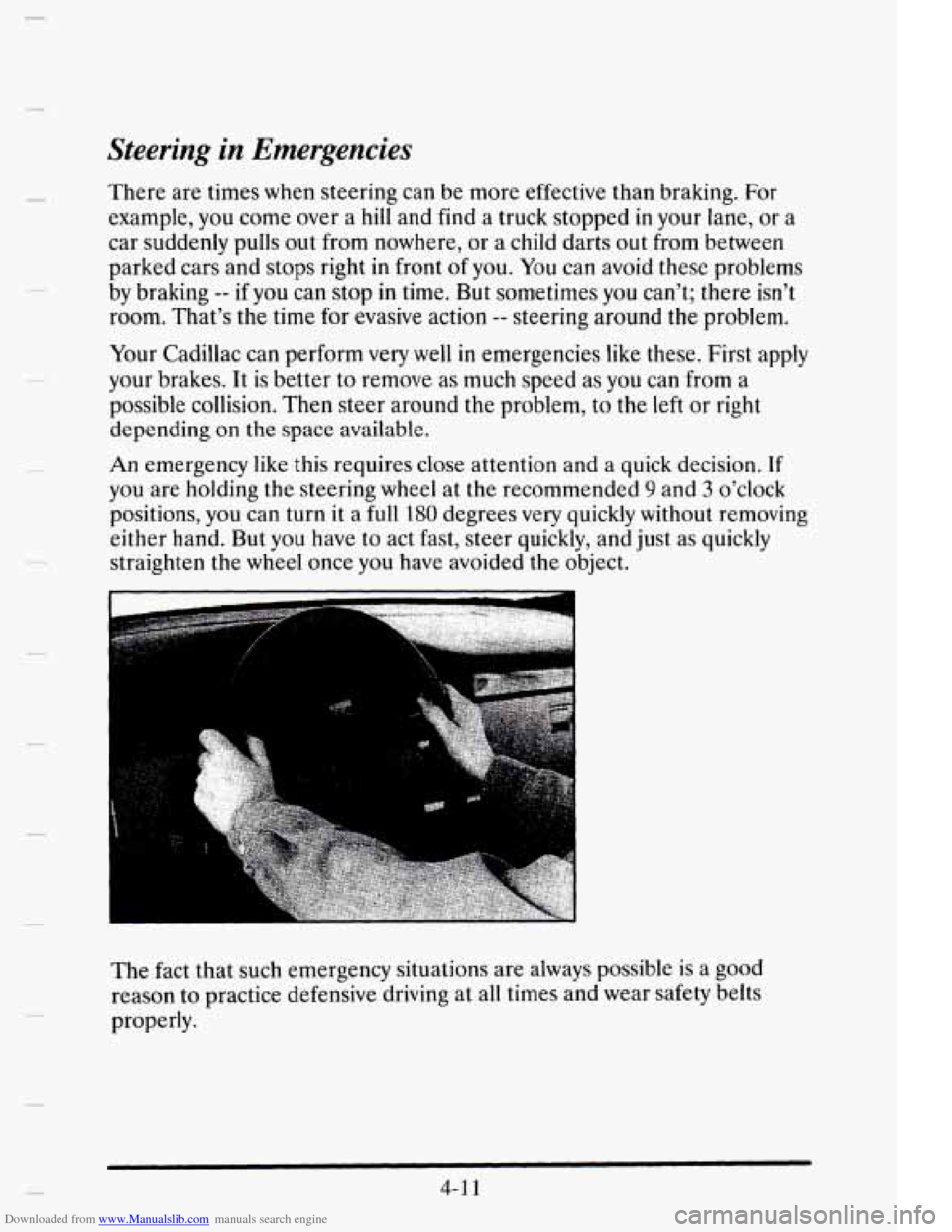
Downloaded from www.Manualslib.com manuals search engine Steering in Emergencies
e
There are times when steering can be more effective than braking. For
example, you come over a
hill and find a truck stopped in your lane, or a
car suddenly pulls out from nowhere, or a child darts out from between
parked cars and stops right
in front of you. You can avoid these problems
by braking
-- if you can stop in time. But sometimes you can’t; there isn’t
room. That’s
the time for evasive action -- steering around the problem.
Your Cadillac can perform very well in emergencies like these. First apply
your brakes. It is better to remove as much speed as you can from a
possible collision. Then steer around
the problem, to the left or right
depending on the space available.
An emergency like this requires close attention
and a quick decision. If
you are holding the steering wheel at the recommended 9 and 3 o’clock
positions,
you can turn it a full 180 degrees very quickly without removing
either hand. But you have to act fast, steer quickly, and just as quickly
straighten the wheel once you have avoided the object.
The fact that such emergency situations are always possible is a good
reason to practice defensive driving at all times and wear safety belts
properly.
4-1 1
Page 226 of 395
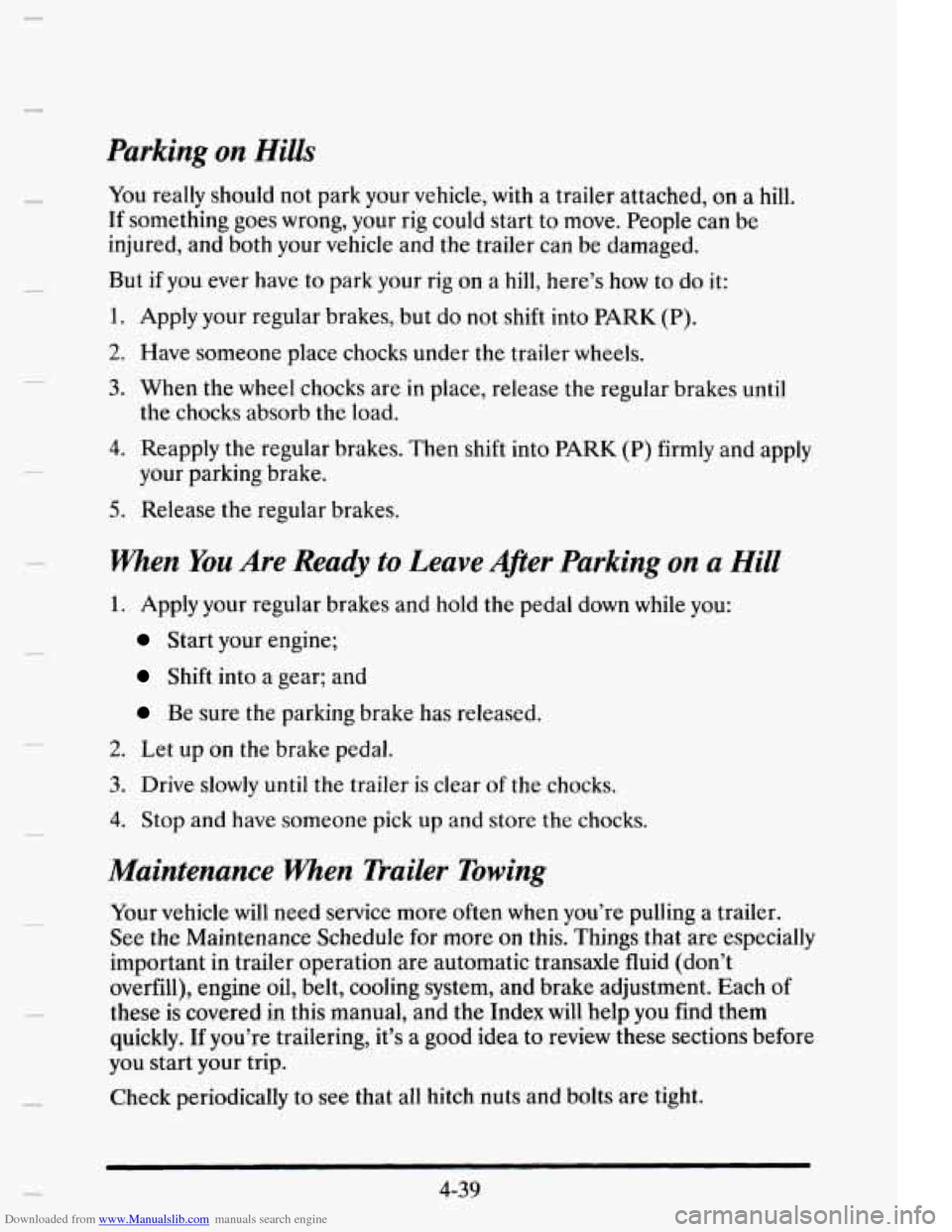
Downloaded from www.Manualslib.com manuals search engine Parking on Hills
c
You really should not park your vehicle, with a trailer attached, on a hill.
If something goes wrong, your rig could start to move. People can be
injured, and both your vehicle and the trailer can be damaged.
But
if you ever have to park your rig on a hill, here’s how to do it:
1. Apply your regular brakes, but do not shift into PARK (P).
2. Have someone place chocks under the trailer wheels.
3. When the wheel chocks are in place, release the regular brakes until
the chocks absorb the load.
4. Reapply the regular brakes. Then shift into PARK (P) firmly and apply
5. Release the regular brakes.
your parking
brake.
When You Are Ready to Leave Afier Parking on a Hill
1. Apply your regular brakes and hold the pedal down while you:
Start your engine;
Shift into a gear; and
Be sure the parking brake has released.
2. Let up on the brake pedal.
3. Drive slowly until the trailer is clear of the chocks.
4. Stop and have someone pick up and store the chocks.
Maintenance When Trailer Towing
Your vehicle will need service more often when you’re pulling a trailer.
See the Maintenance Schedule
for more on this. Things that are especially
important in trailer operation are automatic transaxle fluid (don’t
overfill), engine oil, belt, cooling system, and brake adjustment. Each
of
these is covered in this manual, and the Index will help you find them
quickly.
If you’re trailering, it’s a good idea to review these sections before
you start your trip.
Check periodically to see that all hitch nuts and bolts are tight.
4-39
Page 305 of 395

Downloaded from www.Manualslib.com manuals search engine Buying New Tires
To find out what kind and size of tires you need, look at the Tire-Loading
Information label.
The tires installed on your vehicle when it was new had a Tire
Performance Criteria Specification (TPC Spec) number on each tire's
sidewall. When you get new tires, get ones with that same
TPC Spec
number. That way, your vehicle
will continue to have tires that are
designed to give proper endurance, handling, speed rating, traction, ride
and other things during normal service
on your vehicle. If your tires have
an all-season tread design, the
TPC number will be followed by an MS
(for mud and snow).
If you ever replace your tires with those not having a TPC Spec number,
make sure they are the same size,
load range, speed rating and
construction type (bias, bias-belted or radial) as
your original tires.
Mixing tires could cause you to lose control while driving. If yuu
mix tires of different sizes or types (radial and bias-belted
tires), the vehicle may
not handle properly, and you could hpve a
.. crash. Be sure to use the same size and type tires on all four
wheels.
It's all right to drive with your compact spare, though. It was
' developed for use on your vehicle.
. ..
6-46
Page 314 of 395

Downloaded from www.Manualslib.com manuals search engine Cleaning the Top of the Instrument Panel
Use only mild soap and water to clean the top surfaces of the instrument
panel. Sprays containing silicones or waxes may cause annoying
reflections in the windshield and even make it difficult to see through
the
windshield under certain conditions.
Cleaning Speaker Covers
Vacuum around a speaker cover gently, so that the speaker won’t be
damaged. If something gets
on one of them, follow the steps earlier under
“Using Solvent-Type Cleaner
on Fabric.” Use as little solvent as you can.
Care of Wood Panels
Use a clean cloth moistened in warm soapy water (use mild dish washing
soap).
Dry the wood immediately with a clean cloth.
CARE OF SAFETYBELTS
Keep belts clean and dry.
6-55